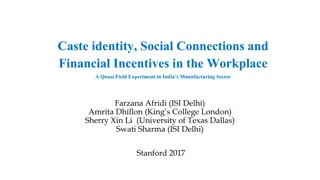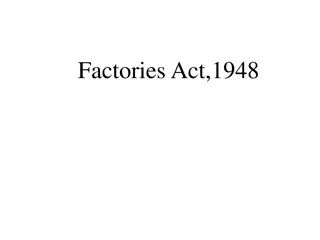Why Heat Transfer Labels are Highly Sought after by Business Owners,WinnersLebel
A heat transfer is an approach of taking a printed image & then going ahead to fix the image directly to the garment. It is done to copy the image on the garment itself. This proven technology is used extensively for customizing t-shirts and in recent times it is used widely for the application of t
0 views • 3 slides
Super Daddio Printed T-shirt, Father's Day Gift
This Father's Day, ditch the ordinary and celebrate the extraordinary with the \"Super Daddio\" t-shirt. It's more than a garment; it's a cape for the everyday superhero in your life \u2013 your dad! It's a way to acknowledge his unwavering strength, his endless support, and the magic he brings to y
0 views • 1 slides
Sequential Label Price Labels Manufacturer In Kolkata India
Sequential numbering labels and related machines are utilized by large garment exporters so as to mark the numbers on the fabric in order to avoid confusion regarding color variation down the stitching line. Hence, we have established our self to deliver labels for different fabrics and varieties wi
1 views • 3 slides
Beyond the Basics_ Unconventional Details for a Unique Look in Salwar suit
The salwar suit, a timeless garment cherished for its comfort and elegance, holds a special place in women\u2019s wardrobes. But with so many variations available, how do you stand out from the crowd and create a truly unique look? This guide delves
0 views • 46 slides
Introduction to Types of Stitches in Garment Manufacturing
Stitching plays a crucial role in garment manufacturing, and there are six main types of stitches: Chain Stitch, Hand Stitch, Lock Stitch, Multi-Thread Stitch, Over-Edge Stitch, and Covering Chain Stitch. Each type has its unique characteristics and uses, determining the quality and durability of th
5 views • 16 slides
Modern Techniques in Apparel Designing and Pattern Development by Mrs. Sonia Khanna
Mrs. Sonia Khanna, an Associate Professor in Home Science, discusses the art of apparel designing and modern pattern development techniques, emphasizing the importance of elements and principles of design in creating garments. The content covers aspects such as structure, functionality, and decorati
0 views • 41 slides
Introduction to Pattern Making in the Fashion Industry
Pattern making is a crucial aspect of garment manufacturing, serving as a template for garment components. It requires technical skills, design interpretation, and construction understanding. The process involves drafting patterns based on measurements before cutting and assembling fabric. Different
3 views • 11 slides
Premium Fold Able Garment Corrugated Box
A Premium Foldable Garment Corrugated Box is designed to provide high-quality protection and presentation for garments. Here are some detailed aspects and features you might find in such a box:
1 views • 3 slides
Fabric Cutting Methods and Techniques for Garment Manufacturing
Fabric cutting is a crucial process in garment manufacturing that involves cutting fabrics according to patterns for quality garments. The cutting department follows a specific workflow to ensure precise cutting and marker planning. Different methods such as manual cutting with hand shears or power
3 views • 25 slides
Garment Processing Techniques for Fading Effects
Learn about garment processing techniques such as PP Spray with Potassium Permanganate, P.P. Sponging, Tagging, and Destroy for creating unique fading effects on denim, twill, poplin, and corduroy garments. Follow safety precautions and specific procedures outlined for each technique.
0 views • 8 slides
Understanding Lay Planning for Efficient Fabric Cutting in Fashion Design
Lay planning is a crucial process in the fashion industry that involves arranging cutting rooms, table spaces, and labor efficiently to optimize fabric spreading and cutting schedules. By effectively managing these resources, production costs can be reduced, fabric wastage minimized, and cutting pro
1 views • 11 slides
The Significance of the Tallit: Understanding the Prayer Shawl
The importance of the Tallit or prayer shawl is highlighted in Scriptures such as Numbers 15:37 and Deuteronomy 22:11. It serves as a reminder for the Jewish people to adhere to the commandments of the Torah throughout generations. This garment is a symbol of devotion and obedience to God's laws, em
0 views • 55 slides
Essential Rules for Pattern Layout in Fashion Design
Proper pattern layout is crucial in garment construction. Press fabric, choose the right fold method, align grain lines, leave space for cutting, pin patterns securely, and use special layouts for specific designs. Following these guidelines ensures efficient cutting and accurate garment constructio
4 views • 11 slides
Understanding Stay Stitching and Easing in Sewing
Stay stitching is crucial for stabilizing fabric edges, especially bias-cut and curved pieces, while easing helps create fullness without compromising garment structure. These techniques are essential in garment construction to ensure proper fit and prevent distortion. Learn where and how to use sta
4 views • 9 slides
Understanding Pattern Making Techniques in Fashion Design
Explore the art of pattern making in the world of fashion design with insights into different types of patterns, dart terminology, and the functions of pattern making tools. Discover how patterns are created, from drafting to draping, and learn about essential tools like plastic grid rulers and Fren
2 views • 24 slides
Overview of Garments Dyeing Process and Advantages
Garments dyeing is the process of coloring garments to achieve the desired shade, with techniques like over-dyeing, dip dyeing, tie dyeing, and tinting. This technology is gaining popularity for various types of clothing, offering advantages such as lower production costs, faster turnaround, and the
0 views • 9 slides
Understanding Garments Dyeing Process in Textile Industry
Garments dyeing is a method of coloring garments to achieve the desired shade, involving processes like over-dyeing, dip dyeing, tie dyeing, and tinting. This technique is gaining popularity for various garments like jeans, shirts, socks, and more due to advantages such as lower production costs, sh
1 views • 9 slides
The Factories Act 1948 - Welfare, Working Hours, and Annual Leave with Wages
The Factories Act 1948 encompasses welfare provisions for workers, including washing facilities, storage for clothing, sitting arrangements, first-aid provisions, canteens, shelters, and more. It mandates basic amenities to ensure the well-being of workers in factories.
2 views • 19 slides
Embrace Elegance and Edge: The Bodycon Leather Dress
The bodycon leather dress stands at the intersection of sophistication and allure, offering wearers a captivating blend of sleekness and edge. With its form-fitting silhouette and luxurious leather construction, this garment exudes confidence, sensua
0 views • 2 slides
The Commonwealth of the Northern Mariana Islands in Transition
The Commonwealth of the Northern Mariana Islands (CNMI) underwent a period of transition due to the impact of various agreements and laws such as the Covenant Agreement, US PL 110-229, and the CNRA Consolidated Natural Resources Act. This transition involved changes in the garment industry, immigrat
0 views • 16 slides
Embrace Elegance and Edge: The Bodycon Leather Dress
The bodycon leather dress stands at the intersection of sophistication and allure, offering wearers a captivating blend of sleekness and edge. With its form-fitting silhouette and luxurious leather construction, this garment exudes confidence, sensua
0 views • 2 slides
Exploring the Life of a Garment Worker Through Reshma's Story
Delve into the daily life of Reshma, a young garment worker in Dhaka, through a heartwarming narrative that portrays the challenges and triumphs of her family. Discover how Reshma's uncle, Raton, steps in to support the family after her father's tragic accident and learn about her younger brother Ba
0 views • 24 slides
Machineries and Tools for Dry Wash Processes in Garment Industry
Garment washing plays a vital role in enhancing the appearance and quality of textiles. This presentation by Md. Hojayfa delves into the machineries and tools utilized in the dry wash processes of the garment industry. It covers the machines used in washing plants, the objectives of washing, dry pro
1 views • 7 slides
Winners Labels Why Heat Transfer Labels Are Highly in Demand by Business Owners
Heat transfer is nothing but a methodology of taking a printed image and getting the image fixed directly on the garment. It is being done in order to get the image copied onto the garment itself. Heat transfer labels proven technology is extensively
0 views • 4 slides
Insights into Garment Printing Industry Trends
Explore the evolution of garment printing businesses like PoPATL and AnaJet, the impact of DTG technology, marketing strategies, and operational efficiencies. Learn about key players like Karl Tipre and PoPATL founders Brian Wynder and Charlie Bunkley.
0 views • 42 slides
Seminar on Garment Recycling Awareness and Techniques
Textile recycling involves reusing or reprocessing used clothing and fibrous materials to reduce waste. The seminar aimed to study garment recycling awareness among housewives from various socio-economic backgrounds. The methodology included data collection through surveys and interviews, with a foc
0 views • 23 slides
Awareness and Techniques of Garment Recycling Among Housewives
This seminar conducted at S.M. Patel College of Home Science focused on studying the awareness of garment recycling and techniques adopted by housewives from different socio-economic backgrounds. The study aimed to promote the reuse and reprocessing of textiles to reduce waste. Through data collecti
0 views • 22 slides
CS Garment, Inc.: Upholding Human Rights and Sustainable Business Practices
CS Garment, Inc. is a reputable company in the Philippines that has been manufacturing high-quality men's woven shirts for export for over 30 years. They are committed to supporting the Ten Principles of the United Nations Global Compact, focusing on human rights, labor standards, environmental prot
0 views • 15 slides
Soft Skills Training Program Evaluation at an Indian Garment Firm
This study evaluates the impact of the P.A.C.E. program, focusing on soft skills training at an Indian ready-made garments firm. The research explores the inculcation and productivity-enhancing effects of soft skills in the workplace, questioning the profitability of general training provided by fir
0 views • 29 slides
Understanding the Judge Me Not Game: Clean vs. Dirty Factories Decision-Making
In the Judge Me Not game, firms must choose between a Clean and a Dirty factory, affecting pollution levels and healthcare costs. The total pollution emitted depends on the number of Dirty factories chosen. With insights from gameplay images and an example scenario, players navigate profitability an
0 views • 7 slides
Enhancing Indian Garment Quality: Zero Defect Strategy & Initiatives
Promoting Indian Garments to Perfection outlines a comprehensive strategy for approaching zero defects in the manufacturing of ready-made garments (RMGs). The presentation covers proposed initiatives, the importance of RMGs in the textile industry, and a vision and mission focusing on achieving glob
0 views • 30 slides
Apple's Controversial Sweatshops in China Exposed by ABC Documentary
Apple's factories in China, particularly in Shenzhen, have come under scrutiny for their harsh working conditions and low wages. Employees work long hours performing monotonous tasks, with some earning as little as $1.12 an hour. Reports of worker suicides and forced overtime have raised concerns, l
0 views • 14 slides
Evolution of Factory Legislation in India: Factories Act, 1948 Overview
Explore the evolution of factory legislation in India through the lens of the Factories Act, 1948. Delve into historical developments, objectives, scope, and provisions regarding health, safety, welfare, working hours, holidays, leave, and special considerations for women and young workers. Understa
0 views • 38 slides
Collective Effects in High-Energy Physics Facilities
Collective effects play a crucial role in Higgs factories and high-energy physics facilities. Impedance effects are proportional to beam-induced voltage, with peak bunch current impacting SB effects and average current affecting MB effects. Factors like beam loading compensation and detuning of the
0 views • 5 slides
Gender Sensitivity Initiatives in Bangladesh Garment Factories
The Ethical Trading Initiative (ETI) in Bangladesh is making strides in promoting gender sensitivity in garment factories. With a focus on systemic change, inclusivity, and quality over quantity, the program aims to create a sustainable and proactive approach. Key findings show a significant increas
0 views • 10 slides
Optimizing Fabric Cutting Efficiency: Lay Planning Methods and Strategies
Lay planning is crucial for managing material, labor, and space in the cutting room. Different methods such as manual lay planning, pantograph scaling, and computerized systems are used to optimize fabric usage. This process involves arranging pattern pieces efficiently on the fabric to minimize was
0 views • 12 slides
Global Trends in Garment Worker Wages: A Closer Look
Explore the dichotomy of garment workers' wages in the global industry, analyzing the race to the bottom versus the potential route out of poverty. Worker Rights Consortium's research sheds light on real wage trends and challenges faced by garment workers in leading exporting countries.
0 views • 34 slides
A Day in the Life of a Garment Worker: Reshma's Story
Reshma, an eighteen-year-old garment worker in Dhaka, shares her story of moving from Kurigram due to a famine. With no food or work, Reshma's family faced hardships before settling in a small house in Kalyanpur. The lesson focuses on reading skills and introduces new words related to Reshma's exper
0 views • 20 slides
Caste Identity and Social Connections in Indian Manufacturing Sector
The study explores the impact of caste identity and social networks on productivity in Indian garment factories. It highlights the persistence of social and economic inequality based on caste, affecting poverty rates and income differentials. The research delves into how caste-based recruitment and
0 views • 31 slides
Historical Development and Objectives of Factories Act, 1948
The Factories Act, 1948, traces its historical development from the early establishment of cotton and jute mills in India to modern factory regulations. The Act aims to ensure the health, safety, and welfare of factory workers, regulate working hours, holidays, and leave, and provide special protect
0 views • 59 slides







































